- Shanghai Cheeshine Novel Materials Technology
- Hai Li
- School of Polymer Materials
- Qingdao University of Science and Technology
Are Bio-Based Materials A Growing Trend Within The Tyre Industry?
- By Sharad Matade & Gaurav Nandi
- July 02, 2025
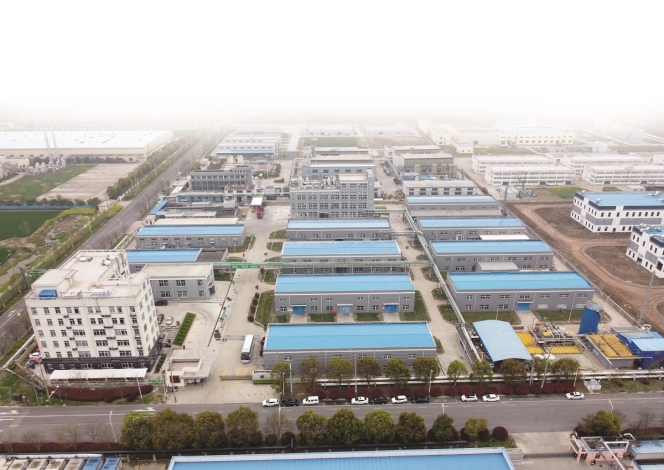
As sustainability becomes central to the tyre industry’s evolution, the spotlight is now shifting from just recyclability and circularity to a newer, promising domain – bio-based materials. While global tyre manufacturers invest heavily in de-carbonisation strategies, companies like Shanghai Cheeshine Novel Materials Technology Co., Ltd. are at the forefront of pushing this transition further. With a growing portfolio of innovative, high-performance bio-based solutions, Cheeshine is betting on the increasing demand for greener alternatives. However, as industry adoption remains cautious, especially in replacing petroleum-derived materials, the road to mainstream acceptance of bio-based materials may still require both technological refinement and a stronger market-driven pull.
Sustainability, recyclability, circularity and renewable materials are the main keywords of the current tyre industry. Companies have invested millions in its efforts towards reaching sustainability goals and attaining a circular economy.
But there is also a new buzz word in town – bio-based raw materials. Cheeshine is confident that the tyre industry has developed an interest towards such materials in its quest towards a sustainable future.
Speaking exclusively to Tyre Trends, the company’s Director of Research and Development Centre, Hai Li, said, “Our goal is to support the rubber industry’s sustainable development. That’s why we’ve selected certain bio-based materials, and through modification, enhanced their properties to make them suitable for rubber applications. There’s growing demand for bio-based materials in tyres due to increased environmental awareness and the need for greener alternatives.”
Founded in 2005 in Shanghai, the company delivers different products and services to the rubber industry. Over more than a decade of growth, the company has expanded its footprint with factories and offices in Jiangsu Huai’an, Jiangsu Suzhou, Shandong Linyi, Hong Kong, Chongqing, Tianjin, India and France, serving a global customer base.
It maintains long-term collaboration with leading Chinese universities and in 2016 established the ‘Cheeshine Scholarship’ at the School of Polymer Materials, Qingdao University of Science and Technology to support innovation in research and development.
With strong research and development capabilities and large-scale production capacity, Cheeshine offers six core product categories including low rolling resistance silane, high-temperature resistant cross-linking agents, wet-skid resistant resins, adhesion promoters, special reinforcing fillers and environmentally friendly processing oils.
It currently holds 108 patents and several technologies for which it has filed PCTs. A standout example is its high dispersion precipitated silica by carbonisation, the precipitated silica via CO₂ substitution for sulfuric acid, a process that currently sets it apart as the only manufacturer with this capability.
MANUFACTURING PROWESS
The company focuses on the ‘magic triangle’, which, in the tyre industry, is referred to the balance between three critical performance factors viz-a-viz rolling resistance, wet grip and wear resistance.
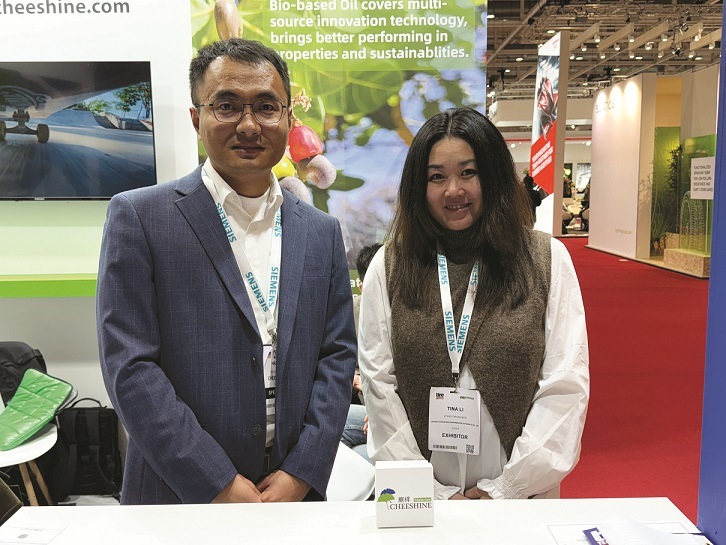
Cheeshine Materials manufactures through its three factories in China and ships worldwide. Its research and development hubs are also located within the country. “We’re a research and development-driven company. Our largest development centre is in Suzhou with over 80 team members, most of whom hold master’s or doctoral degrees. We have a total of three R&D centres. Our teams work closely with clients to co-develop customised and high-performance solutions. We have two main production bases – one in Hua’an, Jiangsu Province, and another in Shandong Province,” said Li.
The company registered a turnover of USD 120 million in 2024 and serves a global base of over 500 customers. Within the tyre industry, it majorly works with the global top 10.
Li expressed pride in the company’s innovations and emphasised on the broad portfolio of rubber additives and sustainable materials. Claiming that the company has a strong market presence both in China and internationally, he provided an overview of the core offerings.
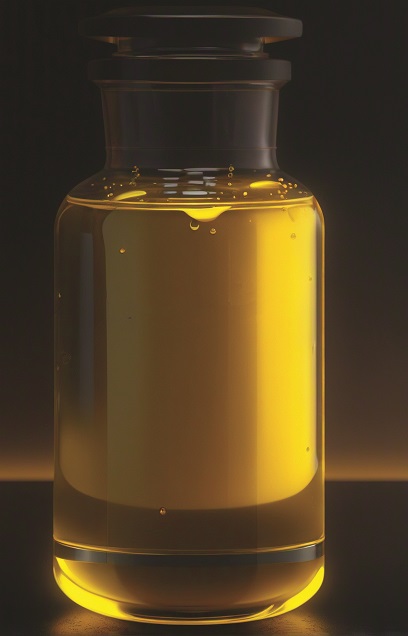 Under the category of bio-based products, Li highlighted a rubber processing oil derived from modified cashew nut shell oil, a product he claimed is manufactured in China only by his company. This oil not only improves compatibility with rubber compounds but also contributes to sustainability. Another innovation was the modified natural rubber (epoxidised NR), developed to serve as a bio-based alternative to synthetic SSBR, offering enhanced performance.
Under the category of bio-based products, Li highlighted a rubber processing oil derived from modified cashew nut shell oil, a product he claimed is manufactured in China only by his company. This oil not only improves compatibility with rubber compounds but also contributes to sustainability. Another innovation was the modified natural rubber (epoxidised NR), developed to serve as a bio-based alternative to synthetic SSBR, offering enhanced performance.
In terms of eco-friendly fillers, he pointed to the high-dispersion precipitated silica by carbonisation, which is more environmentally friendly than traditional sulfuric acid-derived silica and also improves dispersion in rubber compounds. He also mentioned a high-performance liquid rubber additive known for its excellent compatibility and market success.
For advanced functional additives, he cited the modified silane coupling agent, designed to replace TESPT and improve rolling resistance and silica dispersion and currently protected under a PCT patent. The company’s multi-functional cross-linking agent enhances durability and strength, while a line of environmentally friendly accelerators was developed to minimise environmental impact during vulcanisation.
The portfolio also includes speciality resins such as a tear-resistant resin for improved tyre durability and several wet skid-resistant resins, including AMS and modified AMS resin, hydrogenated resin, bio-based resin and modified C5/C9 resin, targeted at enhancing grip on wet surfaces. Additionally, the company produces various phenolic and formaldehyde resins for specific performance attributes like heat resistance and bonding, along with anti-reversion agents and silica dispersion agents that support high-performance compound development.
Among the company’s most cutting-edge innovations is a sulfur-free curing agent, an alternative that replaces traditional sulfur in rubber vulcanisation and enhance tyre ageing resistance and wear resistance while significantly boosting overall durability performance. This agent helps reduce tyre cracking over time and extend product life. Li noted that Cheeshine Materials is currently the only company globally manufacturing this agent and has secured a PCT patent for it.
When asked about the source of their materials, Li acknowledged that while many of the older products were petrochemical-based, the company is now strongly shifting towards bio-based alternatives including bio-oils, resins and natural rubber modifications, in alignment with the industry’s evolving sustainability goals.
MARKET TALK
While the company has a kitty of impressive offerings that might cater to the emerging and evolving demands of the tyre industry, replacing traditional materials completely is a matter that is to be taken up in the near future. Of all the raw materials that go into a tyre, replacing synthetic rubber seems to be a very vague concept for many.
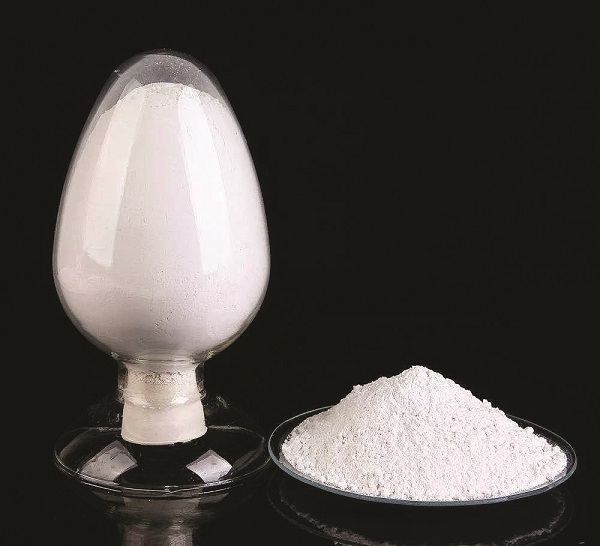 Alluding to why the industry will choose modified natural rubber over SSBR, Li explained, “Modified natural rubber offers higher bio-based content, which supports sustainability goals. Through our proprietary modifications, we enhance its ageing, physical and dynamic properties, making it a strong alternative to synthetic rubber.”
Alluding to why the industry will choose modified natural rubber over SSBR, Li explained, “Modified natural rubber offers higher bio-based content, which supports sustainability goals. Through our proprietary modifications, we enhance its ageing, physical and dynamic properties, making it a strong alternative to synthetic rubber.”
Commenting on challenges, Li said, “Our main challenge is the constant push to develop better products and solutions. Innovation is an ongoing effort. We’re continually working to modify bio-based materials like lignin. Many projects are ongoing, focused on improving sustainability and performance. On the cost front, we aim to keep the cost of our new products on par with conventional ones while providing the added value of sustainability.”
Li described that the business is fairly balanced between domestic and international markets. In terms of global expansion, he mentioned that growth is being driven through a network of affiliates and distributors. The company already has team members based in Paris, Copenhagen and Mumbai and are actively engaging with international partners to access new markets.
In response to questions about the shifting dynamics in Europe, particularly with some local plants shutting down, Li noted that the company is continuing to expand its manufacturing capacity in China. He cited the country’s cost advantages and strong pool of research and development talent as key factors. Looking ahead, the company plans to strengthen its presence in Europe by hiring more local technical support staff to better serve the region.
As for establishing a manufacturing plant in Europe, Li shared that there are no immediate plans to do so. However, the company may consider this move in about two or three years, particularly after the full commissioning of the new domestic plant as part of a longer-term strategy to navigate tariffs and support local demand.
When asked about the future vision, Li stated that Cheeshine Materials’ ambition is to become a true pioneer of the unexplored territories in the rubber industry. The focus remains on leading innovation and continually expanding the company’s global influence.
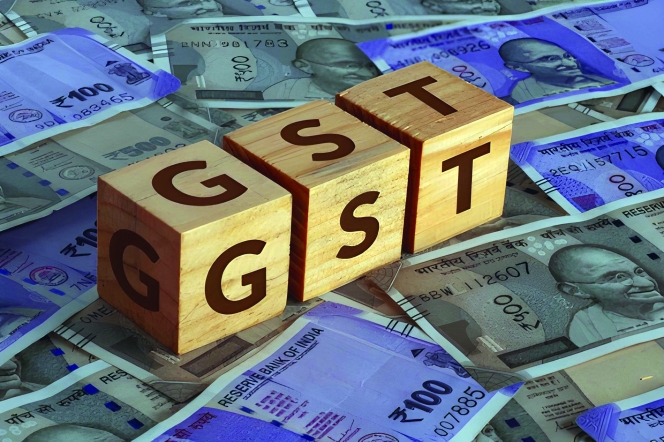
The rollout of GST 2.0 marks a defining moment in India’s economic journey – a reform that may well prove even more consequential than the original introduction of the Goods and Services Tax. Especially for a sector like tyres, the recent reduction in (GST) on tyres is far more than just a change in numbers. It is a transformative step that touches every wheel turning on India’s roads – from a farmer’s tractor to a trucker’s long-haul trailer and from a commuter’s scooter to a construction vehicle powering the nation’s infrastructure.
For years, tyres were taxed at 28 percent – the highest GST slab, clubbed with luxury and demerit goods. This categorisation never truly reflected the essential role tyres play in our everyday lives. Tyres are not a luxury. They are a fundamental enabler of mobility, supporting the movement of people and goods across cities, towns and villages. By bringing GST rates on tyres down to a more rational level, the government has addressed a long-standing anomaly and set the stage for widespread benefits across the economy.
The most visible impact of this move will be felt on the ground – literally. Lower GST means more affordable tyres for all users. Especially for transporters and fleet operators, tyres account for a significant chunk of vehicle running costs. A reduction in tax translates into lower replacement costs, freeing up working capital and improving operational margins. Farmers, small traders, delivery personnel, service providers, transporters – every segment that relies on mobility will feel this relief.
India has been working hard to bring down logistics costs, which are believed to be about 13–14 percent of GDP – much higher than global benchmarks. Tyres have a direct bearing on vehicle operating efficiency, fuel consumption and maintenance schedules. When tyres become more affordable, operators can replace tyres on time, and run vehicles more efficiently.
This naturally leads to lower logistics costs. Reduced logistics costs ripple across the value chain, helping industries move goods faster and at lower cost. This aligns perfectly with India’s ambition to become a more globally competitive manufacturing and trading hub.
Tyre industry’s story is not just urban – it’s deeply rural as well. Tractor tyres, power tiller tyres and tyres for animal-drawn vehicles are integral to the agricultural economy. A reduction in GST brings meaningful relief to farmers and small cultivators who rely on these tyres for their daily operations. By easing this cost, the government has extended direct support to rural mobility and agricultural productivity – an often underappreciated but critical outcome of this reform.
One of the most powerful yet often overlooked impacts of this decision lies in road safety. Worn-out tyres are a major cause of road accidents, particularly on highways. High replacement costs often lead to tyres being used well past their safe life.
With lower GST making new tyres more accessible, both individual motorists and commercial fleet owners are more likely to replace tyres on time, keeping vehicles safer and reducing accident risks. This complements the government’s broader road safety agenda, making highways not just faster but safer for everyone.
For the Indian tyre industry, which is one of the largest in the world, this reform is a game changer. It creates a more balanced tax structure, supports better cash flow, improves compliance and strengthens the competitiveness of domestic manufacturers. It will also encourage investment and capacity expansion, enabling the industry to serve growing domestic demand and tap export opportunities more effectively.
The GST reduction on tyres is a strategic, forward-looking policy decision that will benefit the entire mobility ecosystem. It acknowledges the essential role tyres play – not just as a product, but as a critical enabler of transportation, logistics, rural livelihoods and road safety.
As this reform takes root, its positive impact will be felt by consumers, businesses, farmers and industries alike. The tyre industry, represented by ATMA, welcomes this move wholeheartedly and remains committed to working alongside the government to strengthen India’s journey towards affordable, efficient and safe mobility for all.
The author is Director General of the New Delhi-based tyre industry association, Automotive Tyre Manufacturers’ Association (ATMA).The views expressed here are personal.
WACKER Secures Gold Medal In EcoVadis Sustainability Rating
- By TT News
- December 18, 2025
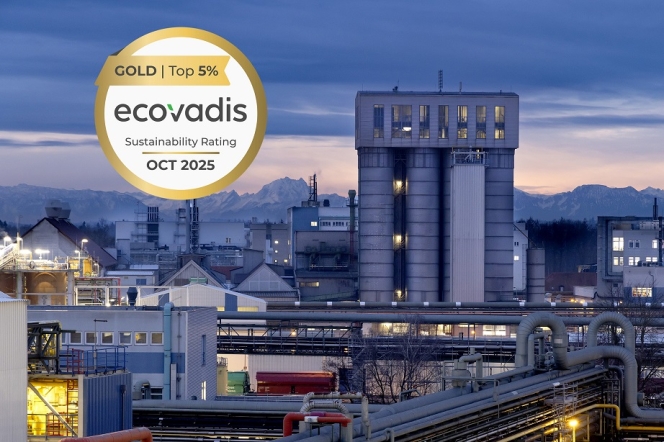
WACKER has earned the 2025 Gold Medal from the independent rating agency EcoVadis, marking its continued recognition for sustainable practices and responsible corporate governance. This distinction places the company within the top five percent of all businesses assessed by EcoVadis (over 1,000 companies globally). WACKER's overall score improved from 77 points (in 2024) to 79 points, driven largely by enhanced reporting and concrete actions focused on Scope 3 emissions and ethical standards.
The EcoVadis assessment measures the quality of a company’s sustainability management through a methodology grounded in international frameworks like the Global Reporting Initiative, the UN Global Compact and ISO 26000. Performance is scored from 0 to 100 across four core areas: environment, labour and human rights, ethics and sustainable procurement, using 21 specific indicators.
In line with its commitment, WACKER provides its EcoVadis evaluation to customers as a standardised and credible validation of its sustainability efforts. The company has also defined ambitious climate targets, aiming to halve its absolute greenhouse gas emissions by 2030 relative to 2020 levels. Progress is already evident, with a 30 percent reduction achieved as of 2024. Looking further ahead, WACKER strives to reach net-zero emissions across its operations by the year 2045.
Peter Gigler, Head of Corporate ESG, WACKER, said, “The result confirms our initiatives in many key areas. It provides our customers with invaluable proof.”
Craig Borman Appointed As Head Of OTR At BKT USA
- By TT News
- December 18, 2025
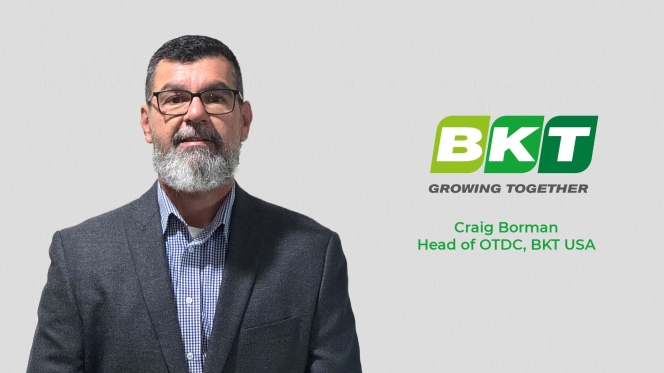
Balkrishna Industries Ltd (BKT Tires), a global leader in off-highway tyre manufacturing, has appointed Craig Borman as Head of OTR at BKT USA. The appointment is in line with BKT’s long-term strategy through 2030.
Borman brings with him 20 years of experience across off-road equipment, tyres and rubber tracks. He will play a key role in leading BKT USA's OTR team and expanding the company's presence in this market while increasing awareness of the value and dependability of BKT's range of products.
Borman said, “I’m extremely excited to join the BKT family and to build off the successes that this team has already achieved. I look forward to engaging with our partners, determining how we can accelerate our mutual growth and working towards achieving BKT’s vision of being a recognised leader in the OTR segment.”
Christian Kötz To Succeed Nikolai Setzer As Continental CEO In Planned Handover
- By TT News
- December 18, 2025
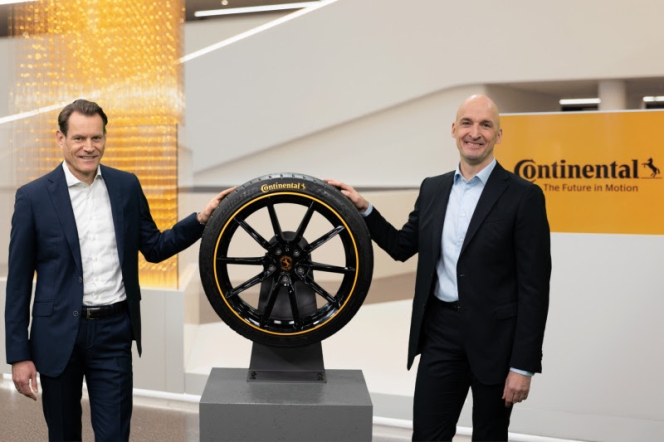
The Supervisory Board of Continental AG confirmed a significant leadership transition during its meeting on 17 December 2025. Christian Kötz will be appointed as the new Chairman of the Executive Board and Chief Executive Officer, effective 1 January 2026. He succeeds Nikolai Setzer, who will step down from the Executive Board on 31 December 2025. Setzer's departure follows more than 16 years as a board member, including the last five years in the CEO role, and occurs by mutual agreement as the company reaches a pivotal point in its strategic evolution.
This planned change in leadership aligns with the substantial progress Continental has made in its transformation into a pure-play tyre company. Major structural milestones have been achieved, including the spin-off of Aumovio and the signing of an agreement to sell the Original Equipment Solutions (OESL) business area. Regarding the planned 2026 sale of ContiTech, internal preparations are largely complete. The market outreach phase has concluded, and a structured sales process is scheduled to begin in January 2026, setting the stage for the final step in the corporate realignment.
Kötz’s extensive background within the tyre business, dating back to 1996, positions him to lead this final phase. A member of the Executive Board since 2019, his previous leadership roles within the Tires group sector included responsibility for the passenger car tyre replacement business in the EMEA region, the original equipment and commercial vehicle tyre business units and global research and development for passenger car tyres. His many years of trusted collaboration with Nikolai Setzer are expected to ensure continuity during the transition.
Kötz will lead an Executive Board comprising several key figures. Alongside him and Philip Nelles, who has headed the ContiTech group sector since 2021, are Roland Welzbacher and Ulrike Hintze. Welzbacher joined the board in August 2025 and assumed the role of Chief Financial Officer on 1 October 2025. Hintze was appointed to the board on 1 July 2025, serving as Chief Human Resources Officer and Director of Labour Relations. This board will be responsible for driving the tyre business forward, completing the corporate realignment and, following the sale of ContiTech, integrating the remaining group functions into the tyre organisation.
Wolfgang Reitzle, Chairman of Continental’s Supervisory Board, said, “Nikolai Setzer has been instrumental in shaping Continental, realigning the organisation and paving the way for three strong, independent companies. For this, he has the thanks of the entire Supervisory Board as well as my personal gratitude. With this handover, we are consolidating responsibility for the tyre business, the realignment and the remaining tasks of the group functions in one role. Christian Kötz is one of the most distinguished managers in the global tyre industry. With his extensive experience and passion for Continental, we firmly believe he is the right choice to lead the company successfully into the future.”
Setzer said, “In recent years, we have succeeded in transforming a diverse portfolio of businesses into three strong, independent champions. After 28 years at Continental, now is the right time for me to hand over responsibility to Christian Kötz. I’m extremely grateful for the journey we’ve all shared and proud of what we’ve all achieved together. I firmly believe that the tyre business, ContiTech, Aumovio and OESL have a promising future ahead.”
Kötz said, “I would like to thank the Supervisory Board for its trust and am excited about this new responsibility. Continental has been my professional home for three decades. Together with the Executive Board team and all colleagues throughout the company, we will complete the realignment and continue the success story of our tyre business.”







Comments (0)
ADD COMMENT